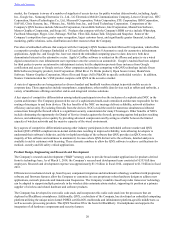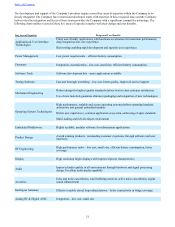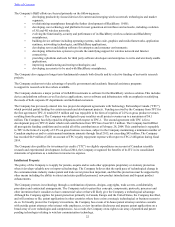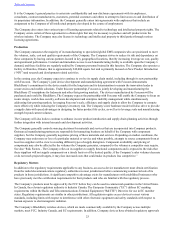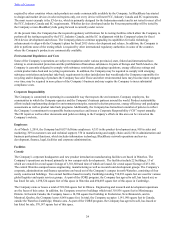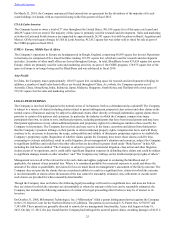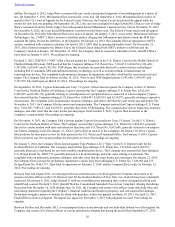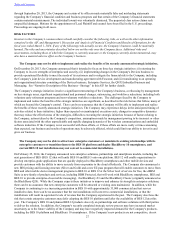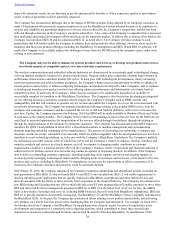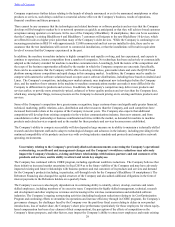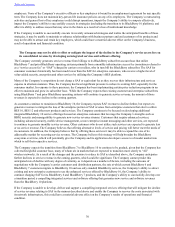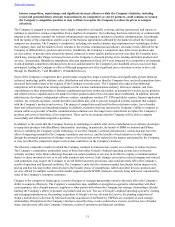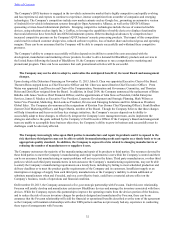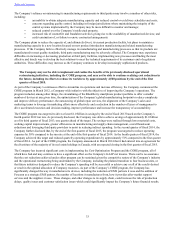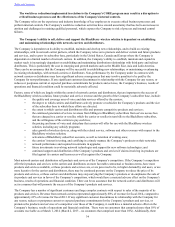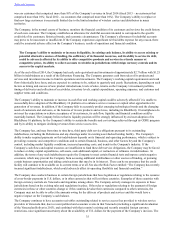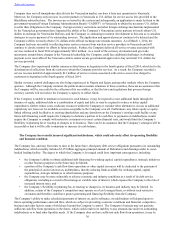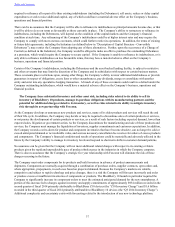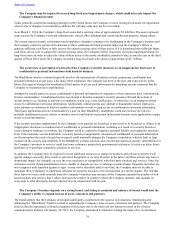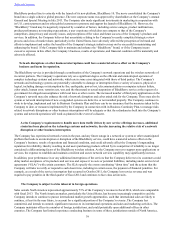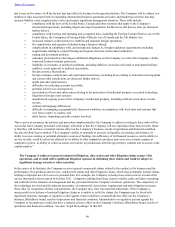Blackberry 2014 Annual Report Download - page 38
Download and view the complete annual report
Please find page 38 of the 2014 Blackberry annual report below. You can navigate through the pages in the report by either clicking on the pages listed below, or by using the keyword search tool below to find specific information within the annual report.
30
employees. None of the Company’s executive officers or key employees is bound by an employment agreement for any specific
term. The Company does not maintain key-person life insurance policies on any of its employees. The Company’s restructuring
activities and general loss of key employees could disrupt operations, impair the Company’s ability to compete effectively,
impact the Company’s ability to successfully execute its strategies (including the transition to its BlackBerry 10 platform), and
affect its ability to address issues that may arise in the future as a result of a loss of institutional knowledge.
If the Company is unable to successfully execute its recently announced strategies and realize the anticipated benefits of those
strategies, it may be unable to maintain or enhance relationships with business partners and end customers of its products and
may not be able to attract and retain key employees, which could have a material adverse effect on the Company's business,
result of operations and financial condition.
The Company may not be able to offset or mitigate the impact of the decline in the Company’s service access fees on
its consolidated revenue by developing an integrated services and software offering.
The Company currently generates service revenue from billings to its BlackBerry subscriber account base that utilize
BlackBerry 7 and prior BlackBerry operating systems primarily from a monthly infrastructure access fee (sometimes referred to
as a “service access fee” or “SAF”) charged to carriers or resellers, who in turn bill the BlackBerry subscriber. The SAF for
consumer customers historically has been much lower than the SAF for enterprise customers, who receive a higher level of
value-added security, encryption and other services by utilizing the Company’s BES platform.
Many of the Company’s competitors do not charge a SAF or equivalent fee as they recover their infrastructure and services
expense in alternate manners. Thus, the Company has faced significant pressure to reduce its existing SAF, especially for the
consumer market. In response to these pressures, the Company has been implementing certain price reduction programs in an
effort to maintain and grow its subscriber base. While the Company expects that existing customer and enterprise subscribers
using BlackBerry 7 and prior BlackBerry operating systems will continue to generate service revenue, the amount of those
revenues is expected to decline in the coming quarters.
As customers continue to transition to BlackBerry 10, the Company expects SAF revenue to decline further, but expects to
generate revenues to mitigate the loss of the enterprise portion of SAF revenue from enterprise customers that elect to utilize
BES 10, BES 12 and other new products and services. The Company continues to be focused on developing additional
integrated BlackBerry 10 service offerings focused on enterprise customers that leverage the Company’s strengths such as
BBM, security and manageability to generate new service revenue streams. Customers that require enhanced services,
including advanced security, mobile device management, secure enterprise instant messaging and other services, are expected
to continue to generate monthly service revenue. Other customers who do not utilize such services are expected to generate less
or no service revenue. The Company believes that offering alternative levels of service and pricing will better meet the needs of
its customers. In addition, the Company believes that by offering these services it may be able to expand the size of its
addressable market for recurring service revenue. The Company believes this strategy will help broaden the BlackBerry
ecosystem over time, which will potentially give the Company and its application developers access to a broader market into
which to sell their respective services.
The Company expects the transition from BlackBerry 7 to BlackBerry 10 to continue to be gradual, given that the Company has
a diversified global customer base, many of whom are in markets that are expected to transition more slowly to “4G”
wireless networks. As a result of the changes and the pressure to reduce its SAF as described above, the Company anticipates
further declines in service revenue in the coming quarters, which could be significant. The Company cannot predict this
anticipated rate of decline with any degree of certainty, as it depends on a number of factors, including the outcome of
negotiations with the Company’s carrier customers and distribution partners, the rate at which current BlackBerry 6 and
BlackBerry 7 customers migrate to BlackBerry 10 and use only standard BlackBerry services, the Company’s ability to attract
existing and new enterprise customers to use the enhanced services offered by BlackBerry 10, the Company’s ability to
continue charging SAF for its BlackBerry 6 and BlackBerry 7 products, and the Company’s ability to successfully develop over
a transition period a compelling integrated services and software offering that generates new service and software revenues
from the BlackBerry 10 platform.
If the Company is unable to develop, deliver and support a compelling integrated services offering that will mitigate the decline
of service revenue relating to SAF in the manner described above and enable the Company to recover the costs associated with
its network infrastructure, this could have a material adverse effect on the Company’s results of operations and financial
condition.
Table of Contents


